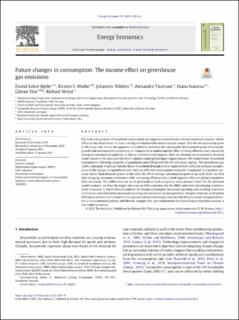| dc.contributor.author | Bjelle, Eivind Lekve | |
| dc.contributor.author | Wiebe, Kirsten Svenja | |
| dc.contributor.author | Többen, Johannes | |
| dc.contributor.author | Tisserant, Alexandre | |
| dc.contributor.author | Ivanova, Diana | |
| dc.contributor.author | Vita, Gibran | |
| dc.contributor.author | Wood, Richard | |
| dc.date.accessioned | 2021-11-15T08:04:46Z | |
| dc.date.available | 2021-11-15T08:04:46Z | |
| dc.date.created | 2021-04-25T13:53:27Z | |
| dc.date.issued | 2021 | |
| dc.identifier.citation | Energy Economics. 2021, 95:105114 1-17. | en_US |
| dc.identifier.issn | 0140-9883 | |
| dc.identifier.uri | https://hdl.handle.net/11250/2829503 | |
| dc.description.abstract | The scale and patterns of household consumption are important determinants of environmental impacts. Whilst affluence has been shown to have a strong correlation with environmental impact, they do not necessarily grow at the same rate. Given the apparent contradiction between the sustainable development goals of economic growth and environmental protection, it is important to understand the effect of rising affluence and concurrent changing consumption patterns on future environmental impacts. Here we develop an econometric demand model based on the data available from a global multiregional input-output dataset. We model future household consumption following scenarios of population and GDP growth for 49 individual regions. The greenhouse gas (GHG) emissions resulting from the future household demand is then explored both with and without consideration of the change in expenditure over time on different consumption categories. Compared to a baseline scenario where final demand grows in line with the 2011 average consumption pattern up until 2030, we find that changing consumer preferences with increasing affluence has a small negative effect on global cumulative GHG emissions. The differences are more profound on both a regional and a product level. For the demand model scenario, we find the largest decrease in GHG emissions for the BRICS and other developing countries, while emissions in North America and the EU remain unchanged. Decreased spending and resulting emissions on food are cancelled out by increased spending and emissions on transportation. Despite relatively small global differences between the scenarios, the regional and sectoral wedges indicate that there is a large untapped potential in environmental policies and lifestyle changes that can complement the technological transition towards a low-emitting society. | en_US |
| dc.language.iso | eng | en_US |
| dc.publisher | Elsevier | en_US |
| dc.rights | Navngivelse 4.0 Internasjonal | * |
| dc.rights.uri | http://creativecommons.org/licenses/by/4.0/deed.no | * |
| dc.subject | Quadratic almost ideal demand system (QUAIDS) | en_US |
| dc.subject | Future environmental impact of consumption | en_US |
| dc.subject | Household consumption | en_US |
| dc.subject | GHG emissions | en_US |
| dc.subject | Multiregional input-output (MRIO) | en_US |
| dc.subject | Scenario analysis | en_US |
| dc.title | Future changes in consumption: The income effect on greenhouse gas emissions | en_US |
| dc.type | Peer reviewed | en_US |
| dc.type | Journal article | en_US |
| dc.description.version | publishedVersion | en_US |
| dc.rights.holder | © 2021 The Author(s). Published by Elsevier B.V. This is an open access article under the CC BY license (http://creativecommons.org/licenses/by/4.0/). | en_US |
| dc.source.pagenumber | 1-17 | en_US |
| dc.source.volume | 95 | en_US |
| dc.source.journal | Energy Economics | en_US |
| dc.identifier.doi | 10.1016/j.eneco.2021.105114 | |
| dc.identifier.cristin | 1906258 | |
| dc.source.articlenumber | 105114 | en_US |
| cristin.ispublished | true | |
| cristin.fulltext | original | |
| cristin.qualitycode | 1 | |

